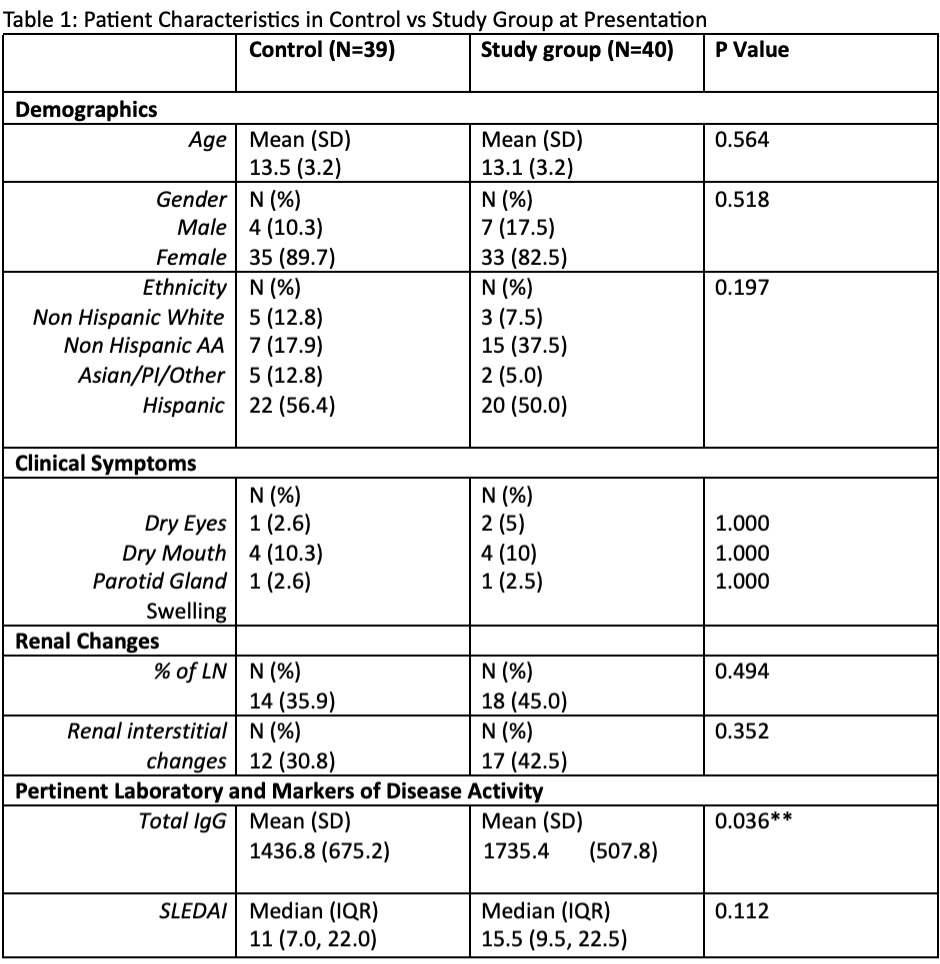Session Information
Session Type: Poster Session B
Session Time: 5:00PM-6:00PM
Background/Purpose: Anti-nuclear antibodies (ANA) are important in the diagnosis of Systemic Lupus Erythematosus (SLE). Of the disease specific ANAs, anti-dsDNA and anti- Smith antibodies carry the most diagnostic power and clinical application. Other specific ANAs which include antibodies to SSA, SSB, and Scl70 are intrinsic component to the understanding of the immune dysregulation of this disease. In adult lupus, these autoantibodies have been described to closely ally with particular clinical features or findings. In this study we sought to explore the clinical significance of SSA and SSB antibodies in pediatric SLE, as to specific disease manifestation and disease severity.
Methods: With BCM IRB approval, we performed a retrospective chart review of patients diagnosed with SLE as per SLICC and EULAR/ACR classification criteria, between 2018 and 2021. We collected clinical and laboratory features, ANAs (per University of Missouri ANA Laboratory) and SLEDAI at presentation, 6 and 12 months and last follow up. Study group consisted of patients with anti-SSA or SSB, while control group without these ANAs. Characteristics are summarized by group and compared using independent t-test, Wilcoxon rank sum, Chi-squared, or Fisher’s exact test.
Results: There were 137 patients diagnosed with SLE during the study period. There were 40 patients in the study group, and 39 in the control group. Mean age was similar between these groups, as well as percentages of Hispanic patients. More African American patients was noted in the study group (37.5% vs 17.9%). Patients in the study group presented with dry eyes (5%), dry mouth (10%), parotid gland swelling (2.5%), none of which was statistically different from control. Mean IgG was higher in the study group when compared to controls (1735.4 v 1436.8, p =0.036). SLEDAI was higher among study patients at presentation, although not statistically different (15.5 vs 11, p=0.112); no significant difference was observed at 6 or 12 months. There was a similar percentage of lupus nephritis between study group and control at presentation (45% vs 35.9%, p=0.494). There were increased interstitial changes in the study group, although not statistically significant (42.5% vs 30.8%, p=0.352). Table 1 summarizes pertinent clinical features and characteristics between groups.
Conclusion: This study showed no increased incidence of sicca symptoms or salivary gland swelling among pediatric SLE patients with anti-SSA and SSB, findings well defined among adults. The study showed that patients with these ANAs have significantly higher IgG at presentation than control. Having SSA and SSB antibodies is not associated with a higher percentage of lupus nephritis. Our study is limited by its retrospective nature and small sample size. A large scale, multicenter study is recommended to study the significance of these antibodies in pediatric SLE.
 SD: standard deviation, AA: African American, PI: Pacific Islander, LN: lupus nephritis, IQR: interquantile range
SD: standard deviation, AA: African American, PI: Pacific Islander, LN: lupus nephritis, IQR: interquantile range
** Represents p values < 0.05
To cite this abstract in AMA style:
Pina Y, Janysek D, Guffey D, Pereira Palacios M, De Guzman M. Clinical Significance of SSA and SSB Antibodies in Pediatric SLE Patients: A Single Center Cohort [abstract]. Arthritis Rheumatol. 2023; 75 (suppl 4). https://acrabstracts.org/abstract/clinical-significance-of-ssa-and-ssb-antibodies-in-pediatric-sle-patients-a-single-center-cohort/. Accessed .« Back to 2023 Pediatric Rheumatology Symposium
ACR Meeting Abstracts - https://acrabstracts.org/abstract/clinical-significance-of-ssa-and-ssb-antibodies-in-pediatric-sle-patients-a-single-center-cohort/
